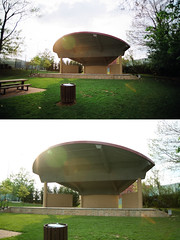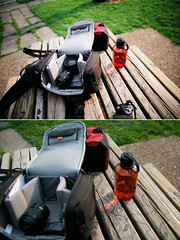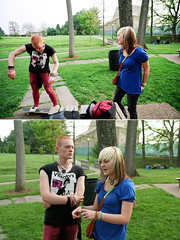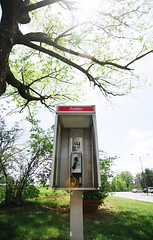Filed under: photography
WARNING: This post may be terribly boring for anyone not interested in photography. Proceed at your own risk.
EDIT: As JTJ pointed out in the comments all my discussion here is not really film vs. digital but instead ‘cd production machine at the 1-hour photo place vs. digital’. It’s still valid for me because that’s exactly how I would and will get film developed (because I am cheap) but it’s … yeah, anyway, read his comment for the rest.
So where to start? I guess I’ll start by saying I recently decided to shoot some film. As I mentioned, Sarah’s pictures got me thinking about film, and I just happened to be able to steal Trey’s camera off of Henry.
I was excited about film for three reasons:
1.) This whole concept of reportedly better tonal range
2.) Lack of chromatic abberration (purple fringing)
3.) Full-frame shots as opposed to cropped sensor
Let me take those one by one. First up, tonal range. I’ve heard people mention that they’ve gone back to film because of greater tonal range. Now I don’t know nothin’ about nothin’ and can’t be bothered to read up on it because my eyes start to glaze over on technical specs and everything seems to be infused with a whole ton of personal opinion anyway. I figured I’d just look for myself. The base idea here is that the film has more detail in the darker and lighter areas than the digital.
Secondly, chromatic abberration comes in many forms but the one with which I am most concerned is the dreaded purple fringe. I’ll let you read the Wikipedia article on fringing since it has pictures and a better description than I can come up with (better than one up with which I can come?). Everything I’ve heard is that film is far less susceptible to this but I wanted to see for myself. Now my digital camera is pretty nice, it’s not bad for producing purple fringing, but I do know situations in which I will encounter it and so I try to avoid them.
Finally, full-frame shooting versus cropped sensor. I will again point you to the relevant Wikipedia article but the oversimplified short version is that the sensor inside my camera is physically smaller than a 35mm piece of film, which means my field of view is reduced and I’m not seeing the true edges of my lenses.
Before I go into the results let me say this: I am an idiot when it comes to Photoshop and color spaces. I don’t really understand what’s going on with them.
I got my film developed and put straight onto CD. When I looked at the pictures they were a bit washed out, and I was disappointed. Then when I took them into Photoshop and did nothing but re-save them the results were a lot better than what I’d been seeing originally. So. I feel that I must have saved them under a different color space, but I don’t know enough to know what I did. I’ll come back to that in a bit.
For reference, I used Fuji 200 film on a Canon EOS Rebel X body. When taking the comparison shots with my Canon Digital Rebel XT I set the ISO to 200 to match.
I’m going to give you this image of the amphitheater at Dogwood Park first:

The top is film, the bottom is digital, both shot with the same Sigma 20mm lens. First up, tonal range: film wins. The best example is the sky: where the digital shows nothing but white the film gives some cloud detail. Though, as said before, I didn’t see this originally when I looked at the images – they were washed out. Photoshop rescued this, and I’ll have to research how.
Past that there was no noticeable fringing on the film, but also none really on digital. The crop factor should be obvious as the digital shows far less than the film.
Second example:

Same layout, top film, bottom digital. The film is far more contrast-y. Oddly enough the orange bottle is more vibrant on film, but the red bag looks better on digital. I have to say that overall the film appeals to me more.
This is the point, though, where I have to say that now that I’ve seen exactly what my digital camera can do as compared to an equivalent film camera I am not ready to abandon it by any means, or start shooting film on a regular basis. The advantage that film has in initial appearance is seriously outweighed by the convenience of digital in every other aspect.
Third comparison:

In this I actually prefer the digital. The film is too contrast-y and has a look that I try to avoid when doing digital post-processing. Initially the film was far too washed out on the skin tones but one quick save in Photoshop and everything has changed. I’m really going to have to go learn more about color spaces.
At this point I had to abandon my digital camera body because I kept fretting too much about taking pictures with film and “wasting” film. I was shooting more with my digital body instead. So, I forced myself to give up the familiar and go out and finish some rolls.
Here’s a shot directly into the sun on a purple fringe test. It passed with flying colors:

A few last things: I bought both Fuji 200 film and Kodak 200 film. Overall there was very little difference in the films. I took some comparison shots of this car and the Kodak came out the winner by the slightest of margins. In the mid tones and shadows the Fuji has a bit more blue whereas the Kodak puts out a bit more red. Still, the Fuji was cheaper and the color difference is definitely not worth the price difference.
All of the pictures I shot on film that were worth uploading are here: film set.
Also, I noticed with the film that my highs were blown out more often than on digital. Should I go out shooting film again I need to be more careful with regards to what I meter off of.
Summary: I really like the way the film looks, but this is only after I take it into Photoshop and re-save. So, therefore, it’s not really any faster to me than taking my digital images into Photoshop and tweaking them ever-so-slightly (or really hard if the situation and my mood warrants). Therefore I’m giving (for me, personally) the winning title to digital based on convenience.
Are you still here? Wake up! Go outside and take some pictures.
8 Comments so far
Leave a comment
Very cool, dude. I’m pleased you took the time to compair the two side by side.
Comment by DoubleT May 6, 2007 @ 8:56 pmEven if one finds subtle improvements in film image quality over digital, the cost of film and the inconsistancies of consumer level film development have me on the side of digital. The only practical advantage that I can see in shooting film is true focal length.
Celluloid is to photography as Harley Davidson is to motorcycles. “Oh my God, single pin crank just feels so much better!” Kiss my ass.
Sorry. How did we get on motorcycles?
First, let me say that this is a good article for starting film/digital discussions. And while I think that your examples can show some some basic differences, I’m afraid (other than the CA fringing) that you’re mostly comparing your digital camera against the scanner that scanned your negatives. To really compare tonal range, color saturation/vibrance etc, you really need to look at prints. There is a lot more info on that film than is contained in those files on the CD.
The first thing that I noticed when I got my CD back today after film processing is that the digital images are much more contrasty than my prints used to be. My guess is that the scanner is doing an auto-levels/curves adjustment.
And speaking of auto-adjustments, the photo print machines at one-hour places also do auto adjustments on your prints. To really know what kind of tonal range you’re getting, you need to take your negatives somewhere that’ll do a print by hand for you (e.g. TTU photo services). They will be able to pull out more tonal range than a machine. Then, you really see what film can do.
Comment by JTJ May 6, 2007 @ 9:38 pmAha, yes, that is a very valid point you make there regarding auto curves and whatnot. I should specify that all my opinions here are regarding how I would most likely get my photos done not the true digital versus film comparison. Thanks for the thoughts on that.
Comment by Kevin O'Mara May 6, 2007 @ 10:00 pmIf you would be getting your photos done “straight-to-CD,” It’s probably best to stick with all-digital.
A DSLR -> Photoshop -> Online workflow is actually much more ‘professional’ than SLR -> one-hour-developing -> CD -> Photoshop -> Online. Whenever you introduce the one-hour people/machines into the process, you’re creating a quality bottleneck that reduces the best photos to near-point-and-click quality.
Now that I’m thinking about it, when we say that a digital photo workflow is simpler than a film workflow, we probably don’t even realize that there’s even more of a complexity difference when you are doing ‘professional or pro-sumer’ photography as opposed to snapshot photography.
Comment by JTJ May 6, 2007 @ 10:24 pmI agree with JJ. The only real differences apparent in these examples is in the processing. And even comparing prints you would still mostly be noticing things that had nothing to do with the image quality but the type of printer used.
That being said, the tonal range is a bit greater with film than with most sub $2000 DSLRs. No real question about that. And with large format negatives like 4×5 the difference is even wider. But it really isn’t that big of a difference, and with the ability to compose an HDR image with digital the scales even out.
The only real thing I notice between the digi/film images is the sharpness. Digital cameras just produce very soft images without any sharpening done in post processing, whereas film is sharp right outta the camera.
The slightly better tonal range of film just isn’t worth the extra hassle in my opinion.
Comment by henry May 6, 2007 @ 10:46 pm[…] “Escape” by Jason Coleman – I’ve recently gotten excited (re-excited?) about photography and learning how to take better pictures. Kevin has a great post and some interesting discussion on his blog about his film vs. digital experimentation. I think, for me, one of the key reason why I only want to shoot in digital, regardless of quality, is the ability to let myself make many mistakes to learn from. Were my camera a film, it would sit mostly on a shelf for fear of taking bad photos. I never had much appreciation for photography until digital allowed me to experiment with it. I never had that feeling with film which no matter how simple the camera, always gave me too great a disconnect between action and feedback to meaningfully learn anything. Related Posts:No related posts […]
Pingback by super-structure | Jason Coleman May 8, 2007 @ 12:19 pmi’m gonna try and surprise myself and keep this really short:
1) Great experiment
Comment by walter May 14, 2007 @ 11:10 am2) The answer, i don’t think, is found in a technological understanding through a/b comparisons of digital/film, but a holistic spiritual meditation on the entirely different natures of digital and analog
3) O’mara: you are a digital photographer. Just like you can’t give Segovia a Les Paul and a stack of hi-watts and expect anything all that impressive. And much like Pete Townsend couldn’t get squat out of the spanish guitar, your photos are not analog. You are a digital creature. The emotional content of your photos are strangely digital. They properly giggle and ache in the digital realm.
Walter, I don’t even know what to make of that thing you just said, but it was interesting. I will consider this reinforcement that I am a digital creature.
Comment by Kevin O'Mara May 14, 2007 @ 3:00 pm